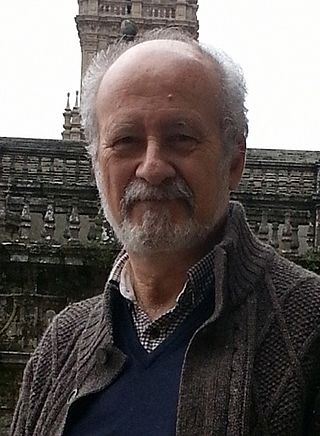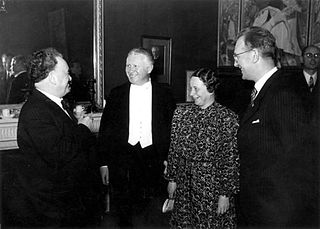A piano sextet is a composition for piano and five other musical instruments, or a group of six musicians who perform such works. There is no standard grouping of instruments with that name, and compared to the string quartet or piano quintet literature, relatively few such compositions exist. The best-known piano sextet is probably the Sextet by Poulenc, one of the pinnacles of the wind and piano repertoire. Chausson's Concert is widely regarded as one of the masterpieces of French strings and piano chamber music literature.
Alfred Uhl was an Austrian composer, violist, music teacher and conductor.

Aarre Merikanto was a Finnish composer.

A viola concerto is a concerto contrasting a viola with another body of musical instruments such as an orchestra or chamber music ensemble. Throughout music history, especially during the Baroque, Classical, Romantic eras, viola was viewed mostly as an ensemble instrument. Though there were a few notable concertos written for the instrument in this time period, these instances were quite rare and the instrument continued to be ignored. However, during the 20th century, the instrument was revitalized thanks to the work of a number of violists and composers, which led to the commission and composition of many more viola concertos, expanding the repertoire significantly.
Nicolas Oreste Flagello was an American composer and conductor of classical music. He was one of the last American composers to develop a distinctive mode of expression based wholly on the principles and techniques of late romanticism.
Arnold Atkinson Cooke was a British composer, a pupil of Paul Hindemith. He wrote a considerable amount of chamber music, including five string quartets and many instrumental sonatas, much of which is only now becoming accessible through modern recordings. Cooke also composed two operas, six symphonies and several concertos.
Volker David Kirchner was a German composer and violist. After studies of violin and composition at the Peter Cornelius Conservatory, the Hochschule für Musik Köln and the Hochschule für Musik Detmold, he worked for decades as a violist in the Radio-Sinfonie-Orchester Frankfurt. He was simultaneously the violist in the Kehr Trio founded by his violin teacher Günter Kehr, and a composer of incidental music at the Hessisches Staatstheater Wiesbaden.
Michel Lethiec is a French classical clarinetist.

José Luis Turina is a Spanish composer, grandson of Joaquín Turina.
Jeajoon Ryu is a South Korean composer. His works have been by performed some of the world’s leading orchestras, such as the Royal Philharmonic Orchestra (RPO), l'Orchestre régional de Cannes-Provence-Alpes-Côte d’Azur (ORCPACA), the Helsinki Philharmonic Orchestra, and the Polish Radio Symphony Orchestra. He was the artistic director of Seoul International Music Festival from 2009-2010 and a composer of Poland Gozow Philharmonic Orchestra from 2011-2012. Artists such as Arto Noras, Michel Lethiec, Ralf Gothoni, Li-Wei Qin, Shanghai Quartet, Juyung Baek, So-Ok Kim, Johannes Moser and Ilya Gringolts were performed his works.
The Sextet is a two-movement composition for clarinet, horn, violin, viola, cello, and piano by Polish composer Krzysztof Penderecki. The composition was written in 2000 and is, according to some critics, the composer's most substantial chamber work.
The Prelude for Clarinet in B-flat major, sometimes also referred to as Prelude for Solo Clarinet, is a work by Polish composer Krzysztof Penderecki. It was composed in 1987 and is one of the pieces from the series of compositions for solo instruments that Penderecki composed during the 1980s, such as Cadenza for Solo Viola (1984) and Per Slava (1986).
The Clarinet Quartet, also known as Quartet for Clarinet and String Trio, is a work for clarinet, violin, viola, and cello by Polish composer Krzysztof Penderecki. It was finished in 1993.
Three Miniatures for Clarinet and Piano is an early work by Polish composer Krzysztof Penderecki. It was finished in 1956, but was premiered four years later.

Egon Kornauth was an Austrian composer and music teacher.
Joseph Phibbs is an English composer of orchestral, choral and chamber music. He has also composed for theatre, both in the UK and Japan. Since 1998 he has written regularly to commissions for Festivals, for private sponsors, and for the BBC, which has broadcast premieres of his orchestral and chamber works from the Proms and elsewhere. His works have been given premieres in Europe, the United States and the Far East, and he has received prestigious awards, including most recently a British Composer Award, and a Library of Congress Serge Koussevitzky Music Foundation Award. Many of his works have been premiered by leading international musicians, including Dame Evelyn Glennie, Esa-Pekka Salonen, Leonard Slatkin, Sakari Oramo, Vasily Petrenko, Gianandrea Noseda, and the Belcea Quartet.
The bassoon repertoire consists of pieces of music composed for bassoon as a principal instrument that may be performed with or without other instruments. Below is a non-exhaustive list of major works for the bassoon.




